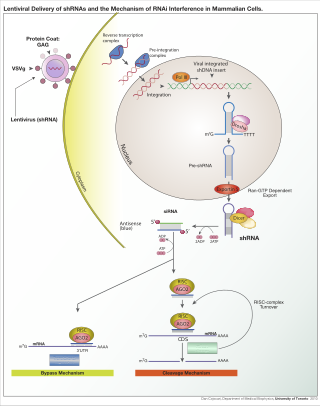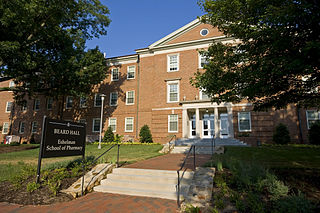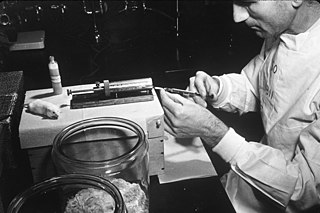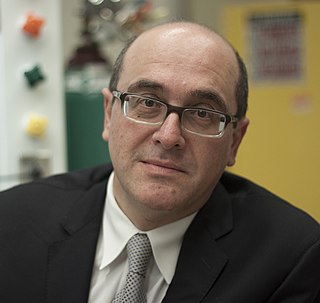
Gene therapy is a medical technology that aims to produce a therapeutic effect through the manipulation of gene expression or through altering the biological properties of living cells.
Transfection is the process of deliberately introducing naked or purified nucleic acids into eukaryotic cells. It may also refer to other methods and cell types, although other terms are often preferred: "transformation" is typically used to describe non-viral DNA transfer in bacteria and non-animal eukaryotic cells, including plant cells. In animal cells, transfection is the preferred term as transformation is also used to refer to progression to a cancerous state (carcinogenesis) in these cells. Transduction is often used to describe virus-mediated gene transfer into eukaryotic cells.
Saghir Akhtar is professor of pharmacology in the College of Medicine, Qatar University, and editor in chief of the Journal of Drug Targeting.

A short hairpin RNA or small hairpin RNA is an artificial RNA molecule with a tight hairpin turn that can be used to silence target gene expression via RNA interference (RNAi). Expression of shRNA in cells is typically accomplished by delivery of plasmids or through viral or bacterial vectors. shRNA is an advantageous mediator of RNAi in that it has a relatively low rate of degradation and turnover. However, it requires use of an expression vector, which has the potential to cause side effects in medicinal applications.

Cationic liposomes are spherical structures that contain positively charged lipids. Cationic liposomes can vary in size between 40 nm and 500 nm, and they can either have one lipid bilayer (monolamellar) or multiple lipid bilayers (multilamellar). The positive charge of the phospholipids allows cationic liposomes to form complexes with negatively charged nucleic acids through ionic interactions. Upon interacting with nucleic acids, cationic liposomes form clusters of aggregated vesicles. These interactions allow cationic liposomes to condense and encapsulate various therapeutic and diagnostic agents in their aqueous compartment or in their lipid bilayer. These cationic liposome-nucleic acid complexes are also referred to as lipoplexes. Due to the overall positive charge of cationic liposomes, they interact with negatively charged cell membranes more readily than classic liposomes. This positive charge can also create some issues in vivo, such as binding to plasma proteins in the bloodstream, which leads to opsonization. These issues can be reduced by optimizing the physical and chemical properties of cationic liposomes through their lipid composition. Cationic liposomes are increasingly being researched for use as delivery vectors in gene therapy due to their capability to efficiently transfect cells. A common application for cationic liposomes is cancer drug delivery.

Gene delivery is the process of introducing foreign genetic material, such as DNA or RNA, into host cells. Gene delivery must reach the genome of the host cell to induce gene expression. Successful gene delivery requires the foreign gene delivery to remain stable within the host cell and can either integrate into the genome or replicate independently of it. This requires foreign DNA to be synthesized as part of a vector, which is designed to enter the desired host cell and deliver the transgene to that cell's genome. Vectors utilized as the method for gene delivery can be divided into two categories, recombinant viruses and synthetic vectors.
Microbubbles are bubbles smaller than one hundredth of a millimetre in diameter, but larger than one micrometre. They have widespread application in industry, medicine, life science, and food technology. The composition of the bubble shell and filling material determine important design features such as buoyancy, crush strength, thermal conductivity, and acoustic properties.

The UNC Eshelman School of Pharmacy is located at the University of North Carolina at Chapel Hill, and includes a satellite campus at UNC Asheville. The Asheville School of Pharmacy campus opened in 2011, and graduated its first class in 2015.

Gene therapy utilizes the delivery of DNA into cells, which can be accomplished by several methods, summarized below. The two major classes of methods are those that use recombinant viruses and those that use naked DNA or DNA complexes.

Ram I. Mahato is a professor and chairman of the Department of Pharmaceutical Sciences, University of Nebraska Medical Center, Omaha, United States. He was Professor of Pharmaceutical Sciences and Biomedical Engineering at the University of Tennessee Health Science Center, Memphis. He was Research Assistant Professor at the University of Utah, Senior Scientist at GeneMedicine Inc and a postdoctoral fellow at the University of Southern California, Washington University in St. Louis, and Kyoto University. He received a PhD in drug delivery from the University of Strathclyde and BS from China Pharmaceutical University. He is a CRS Fellow, AAPS Fellow, Permanent Member of BTSS/NIH Study section (2009–2013), and ASGCT Scientific Advisor.
Aliasger K. Salem is the Associate Vice President for Research at the University of Iowa and Bighley Chair and Professor of Pharmaceutical Sciences at the University of Iowa College of Pharmacy. Salem's academic appointment at the University of Iowa is based in the College of Pharmacy, with additional secondary appointments in the College of Dentistry, Department of Chemical and Biochemical Engineering, Department of Biomedical Engineering, Department of Chemistry, and the Holden Comprehensive Cancer Center. Prior to joining the University of Iowa in 2004, he was a postdoctoral fellow at the Johns Hopkins School of Medicine and completed his PhD at the School of Pharmacy and Pharmaceutical Sciences at the University of Nottingham in the UK.

Elizabeth Wayne is an Assistant Professor of Biomedical Engineering and Chemical Engineering at Carnegie Mellon University and former Postdoc at the Center for Nanotechnology in Drug Delivery at the University of North Carolina at Chapel Hill. Wayne was a 2017 TED fellow and is a member of a number of professional societies, including the National Society of Black Physicists.
Juliane Nguyen is a professor at UNC Eshelman School of Pharmacy. She received her PharmD and PhD from Philipps-Universität Marburg in Germany, completing her PhD in Thomas Kissel's group. After receiving her degrees, she completed a Post doc with Francis Szoka at University of California, San Francisco. Her research is focused on exosomes and lipid based drug delivery systems. She was awarded a National Science Foundation CAREER award in 2018 for her work as well as over $13M from the NIH and other funding sources. Nguyen’s work has been recognized with numerous awards, including the CMBE Young Innovator Award (2019) from the Biomedical Engineering Society, the AAPS Emerging Leader Award (2019), the NYSTAR Faculty Award (2019), the National Science Foundation CAREER Award (2018), the Pioneering Pharmaceutical Sciences by Emerging Investigators Award (2018), and the University at Buffalo – Exceptional Scholar Young Investigator Award (2017). Nguyen is a Fellow of the Controlled Release Society (2023).
Chae Ok-Yun is a Korean-born scientist, Professor of Bioengineering at Hanyang University, Seoul, Korea.
Richard Jude Samulski is an American scientist, inventor, and academic recognized for his pioneering work in gene therapy and adeno-associated virus vectors (AAV) in the fields of molecular virology and pharmacology.

Debra Auguste is an American chemical engineer and professor at Northeastern University in the department of chemical engineering. Auguste is dedicated to developing treatments for triple negative breast cancer, one of the most aggressive and fatal cancers that disproportionately affects African American women. Her lab characterizes biomarkers of triple negative breast cancer and develops novel biocompatible therapeutic technologies to target and destroy metastatic cancer cells. Auguste received the 2012 Presidential Early Career Award for Scientists and Engineers and in 2010 was named in the 50 Most Influential African-Americans in Technology. In 2020, Auguste became an Elected Fellow of the American Institute for Medical and Biological Engineering.
Walter Henry Hartung was an American pharmaceutical chemist. His work studied the chemical and biological properties of amines.

Hydrodynamic Delivery (HD) is a method of DNA insertion in rodent models. Genes are delivered via injection into the bloodstream of the animal, and are expressed in the liver. This protocol is helpful to determine gene function, regulate gene expression, and develop pharmaceuticals in vivo.

Alexander Viktorovich Kabanov, is a Russian and American chemist, an educator, an entrepreneur, and a researcher in the fields of drug delivery and nanomedicine.
David Terry Curiel is an American cancer biologist. He is a professor of Radiation Oncology at Washington University School of Medicine and Director of the Biologic Therapeutics Center. In 1995, Curiel led a research team who were the first to develop a vaccine based on messenger RNA. Although they published proof of concept, he could not continue testing due to a lack of funding. In 2021, Curiel developed a vaccine that targets the SARS-CoV-2 virus through the nose.









